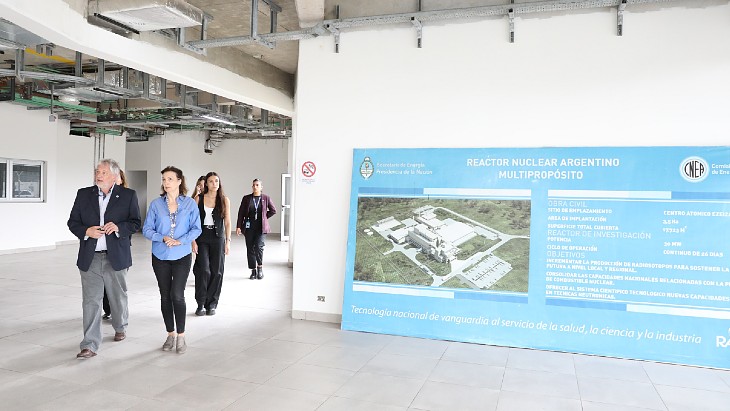Mondino, who assumed office in December after the election of Javier Milei as Argentina's President, praised the progress taking place at RA-10, and also the neighbouring CONUAR nuclear fuel plant. She said the foreign ministry would continue to support the nuclear sector's export efforts, noting "the opportunities that open up for Argentine, if they are well managed and if we manage to demonstrate quality".
Manager of the RA-10 project, Herman Blaumann, gave an update on progress, saying that it was now 80% complete: "The civil work is already finished and in terms of supplies and installations the progress is 75%. This week the reactor's reflector tank will arrive ... the installation of which is another key step in the work."
He also said that the aim was to fill the reactor pool in December, and then in July 2025 pre-operational tests will begin before it becomes operational in 2026.
Argentina's National Atomic Energy Commission (CNEA) says the RA-10 - a 30 MWt open-pool research reactor - will be used for the production of medical radioisotopes, including the capacity to cover 20% of the world demand for molybdenum: "Technetium is obtained from molybdenum, and widely used in nuclear medicine ... it will also be possible to produce other radioisotopes that are not made in the country today and that are widely used in the world, such as lutetium, which is applied to treat prostate cancer and other pathologies, as well as others for use in agriculture and the industry".
The RA-10 project was approved by the government and was officially started by CNEA in June 2010. Argentina's Nuclear Regulatory Authority granted a construction licence for RA-10 in November 2014. The civil works for the reactor began in 2016. Nuclear technology firm INVAP is involved in the design and construction of the reactor facility and related installations, playing the role of main contractor. The assembly of the RA-10 pool - which will house the core of the reactor - was completed in August 2018.
The RA-10 will replace the RA-3 reactor on the same site. This 10 MWt pool-type reactor began operations in 1967. As well as producing radioisotopes it will also provide new research and training opportunities and will have associated facilities such as the Argentine Neutron Beam Laboratory (LAHN) and the Laboratory for the Study of Irradiated Materials (LEMI).
CNEA says that more than 80 companies in Argentina are involved in the work, with the minister also told about the hopes for RA-10 "production of silicon doped by neutron transmutation, a very high quality raw material for the development of advanced electronic applications. And it will produce sources of industrial iridium for the evaluation of the integrity and quality of large constructions and components".
Meanwhile, there was also a key moment this week with the passing of tests of the reflector tank, manufactured by INVAP and designed by CNEA, for the new reactor. INVAP Vice President Felipe Albornoz said it was an important milestone "being able to finish a component that is the heart of the RA-10 reactor, along with the reactor core. All the rest of the facility is built around these components and being able to imagine it, design it and then manufacture it in our country, with our people in Bariloche, is a reason for pride and a reason for celebration".
CNEA President Adriana Serquis said it is an important moment "both for what it means and a new milestone for the nuclear development of our country, as well because it will provide us with new capabilities that are highly required internationally, whether in the area of medicine, with the production of radioisotopes, and the facilities for the production of silicon, the testing of materials and the enormous advance for the area of science and technology in the use of neutrons".
The reflector tank weighs 2540 kilogrammes, is 2 metres in diameter and 1.4 metres tall. Its installation will allow the assembly of the reactor pool internals.
Blaumann said: "The project is approaching its final stage. The reflector tank is the most complex component of the reactor and at the same time critical for all its applications to be developed."





_30199.jpg)
_72306.jpg)

_49562.jpg)





